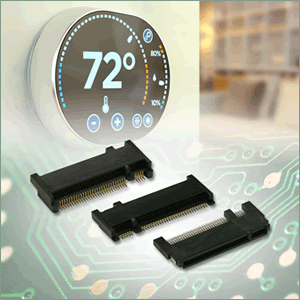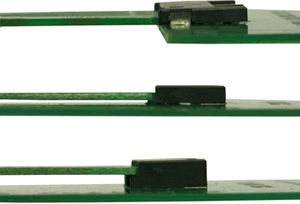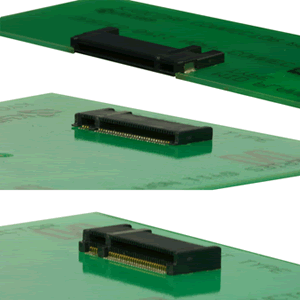M.2 Connectors for Sleek Smart Home Electronics
Due to the especially personal nature of homes, smart home electronics must be user-friendly, aesthetically pleasing, and as subtle as possible. The new M.2 connector is designed for use with a wider range of module widths and lengths, and especially smaller computer expansion cards that operate at faster transfer speeds.
Intelligent devices are exploding in popularity. This trend, sparked by smartphones, has been embraced by cars, household appliances, watches, and other wearables, and is now extending into homes and commercial buildings. Smart homes allow people to control thermostats, security devices, lighting, and connected appliances with multifunction remotes, wall-mounted touchscreens, smartphones, and other web-enabled devices, and can even be automated to monitor and control these devices for optimum comfort and efficiency.
Due to the especially personal nature of homes, smart home electronics must be user-friendly, aesthetically pleasing, and as subtle as possible. In light of this, engineers who design smart home devices are challenged to make them ever smaller while retaining all of their current capabilities, and often while incorporating more. The quickest way to reduce the size of an electronic device is to reduce the size of its PCB, which requires a combination of creative space management and reduced-size components.
Card edge connectors are typically some of the biggest components on a PCB, largely due to their ability to couple modular expansion cards. The well-established trend toward smaller, sleeker, and lighter electronics has long had connector manufacturers striving to achieve smaller profiles and footprints, often while simultaneously improving performance and reliability. To help satisfy these goals, connector manufacturers have recently released several new designs, including an M.2 card edge connector designed to accept dual-sided module cards loaded with additional components for expanded capabilities and another that is terminated into, rather than onto, a PCB – reducing its profile height to a mere 1.8mm.

Figure 1: M.2 card edge connectors are available in several different height and keying options to provide solutions for a multitude of applications that require the use of module cards.
The user interfaces of smart home devices must be wireless-compatible to be relevant in the market. Components that provide this feature, like wireless module cards and the connectors that accept them, are large compared to other board-level components, but the latest specification for these components has made them significantly smaller. Formerly known as NGFF (next-generation form factor), the M.2 specification for internally mounted computer expansion cards and connectors is the successor to the mSATA (miniature serial AT attachment) specification, which uses the PCI Express Mini Card physical layout and connectors.
Featuring a more flexible physical specification than its predecessor, in addition to more advanced interfacing capabilities, M.2 is designed for use with a wider range of module widths and lengths, and especially smaller computer expansion cards that operate at faster transfer speeds. These sleek, Wi-Fi, WWAN, and SSD expansion cards are entered into card edge connectors that are virtually identical, regardless of the manufacturer, due to the rigid M.2 criteria for pin count and keying layouts, depending on which capability the expansion card provides. As such, connector manufacturers are distinguishing themselves by offering different mounting options for this seemingly universal M.2 connector design.

Figure 2: M.2 card edge connectors in three height variations – from top to bottom: 1.8mm, 2.3mm, and 3.2mm – and the module card location of each relative to the PCB post-insertion
These various mounting options primarily affect the above-board height of a connector and the location of the module’s seating plane, which is where the card edge of a module enters a connector. Designed to leave just enough space for the bottom of the module card to clear the mounting surface of the host PCB, standard M.2 card edge connectors stand a slight 2.3mm high, but, beyond contributing to PCB size reductions and connecting an M.2 module card, offer no unique benefits with regard to performance.
Consequently, due to smart home market demands for both PCB size reductions and expanded capabilities, several connector manufacturers have introduced 3.2mm M.2 connectors designed to accept dual-sided module cards. Nearly a full millimeter taller than standard M.2 connectors, 3.2mm M.2 connectors increase the height of the module’s seating plane to accept module cards outfitted with additional components, which compensate for the minimal height they add to a design by enabling the improved functionality that consumers desire.

Figure 3: A midplane-mounted M.2 connector with metal tabs for additional retention force (top); a standard M.2 connector for single-sided module cards (middle); and an M.2 connector with a raised housing for dual-sided module cards (bottom)
A few connector manufacturers have also introduced M.2 connectors with an even slimmer module seating plane than the 2.3mm version. This new height, largely driven by the thinning of electronic devices like tablets and notebook PCs, is achieved by cutting into the host PCB, which is an innovative workaround solution to the fact that further adjustments to the size of the actual connector aren’t compatible with the universal M.2 requirements. Measuring just 1.8mm high, these latest M.2 card edge connectors are half a millimeter shorter than the standard height, which might not sound significant, but definitely is. Due to the widespread availability of components with dramatically reduced form factors — including FFC/FPC cables with thicknesses of 0.3mm or less, and capacitors with profile heights as low as 0.18mm — the half-millimeter space savings that these new M.2 connectors deliver can allow engineers to run a cable or populate components where there once wasn’t room, providing them with another effective solution for simultaneously shrinking PCB size while increasing functionality.
Ultimately, achieving increasingly capable smart home electronics with sleeker, subtler, and more attractive physical forms requires the combined efforts of several links in the electronics supply chain, but innovative, reliable, and cost-effective component-level solutions, like these new M.2 card edge connectors, will always be essential to effectively minimizing the size of a PCB while simultaneously increasingly its functionality.
Author Daniel West is a field application engineer at AVX.
[related_posts limit=”7″]






